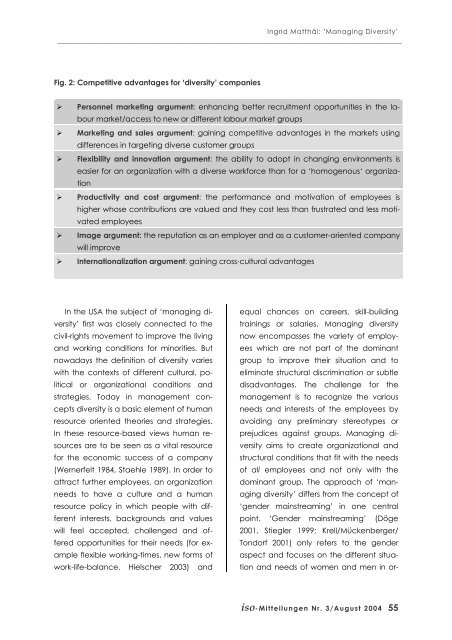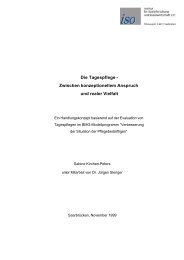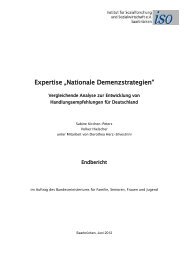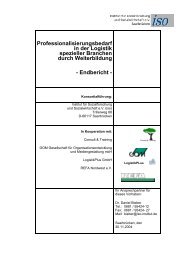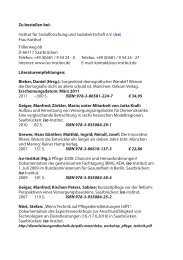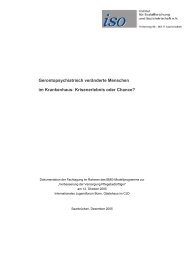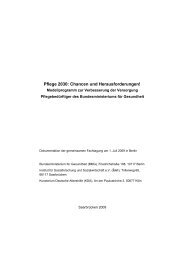iso-NEWS - Institut für Sozialforschung und Sozialwirtschaft eV
iso-NEWS - Institut für Sozialforschung und Sozialwirtschaft eV
iso-NEWS - Institut für Sozialforschung und Sozialwirtschaft eV
Sie wollen auch ein ePaper? Erhöhen Sie die Reichweite Ihrer Titel.
YUMPU macht aus Druck-PDFs automatisch weboptimierte ePaper, die Google liebt.
Ingrid Matthäi: ’Managing Diversity’<br />
__________________________________________________________________________________________<br />
Fig. 2: Competitive advantages for ‘diversity’ companies<br />
� Personnel marketing argument: enhancing better recruitment opportunities in the la-<br />
bour market/access to new or different labour market groups<br />
� Marketing and sales argument: gaining competitive advantages in the markets using<br />
differences in targeting diverse customer groups<br />
� Flexibility and innovation argument: the ability to adopt in changing environments is<br />
easier for an organization with a diverse workforce than for a ‘homogenous‘ organiza-<br />
tion<br />
� Productivity and cost argument: the performance and motivation of employees is<br />
higher whose contributions are valued and they cost less than frustrated and less moti-<br />
vated employees<br />
� Image argument: the reputation as an employer and as a customer-oriented company<br />
will improve<br />
� Internationalization argument: gaining cross-cultural advantages<br />
In the USA the subject of ‘managing diversity’<br />
first was closely connected to the<br />
civil-rights movement to improve the living<br />
and working conditions for minorities. But<br />
nowadays the definition of diversity varies<br />
with the contexts of different cultural, political<br />
or organizational conditions and<br />
strategies. Today in management concepts<br />
diversity is a basic element of human<br />
resource oriented theories and strategies.<br />
In these resource-based views human resources<br />
are to be seen as a vital resource<br />
for the economic success of a company<br />
(Wernerfelt 1984, Staehle 1989). In order to<br />
attract further employees, an organization<br />
needs to have a culture and a human<br />
resource policy in which people with different<br />
interests, backgro<strong>und</strong>s and values<br />
will feel accepted, challenged and offered<br />
opportunities for their needs (for example<br />
flexible working-times, new forms of<br />
work-life-balance, Hielscher 2003) and<br />
equal chances on careers, skill-building<br />
trainings or salaries. Managing diversity<br />
now encompasses the variety of employees<br />
which are not part of the dominant<br />
group to improve their situation and to<br />
eliminate structural discrimination or subtle<br />
disadvantages. The challenge for the<br />
management is to recognize the various<br />
needs and interests of the employees by<br />
avoiding any preliminary stereotypes or<br />
prejudices against groups. Managing diversity<br />
aims to create organizational and<br />
structural conditions that fit with the needs<br />
of all employees and not only with the<br />
dominant group. The approach of ‘managing<br />
diversity’ differs from the concept of<br />
‘gender mainstreaming’ in one central<br />
point. ‘Gender mainstreaming’ (Döge<br />
2001, Stiegler 1999; Krell/Mückenberger/<br />
Tondorf 2001) only refers to the gender<br />
aspect and focuses on the different situation<br />
and needs of women and men in or-<br />
<strong>iso</strong>-Mitteilungen Nr. 3/August 2004 55


